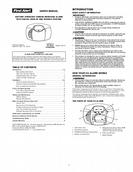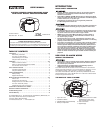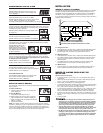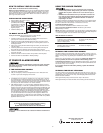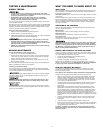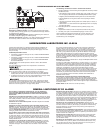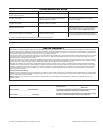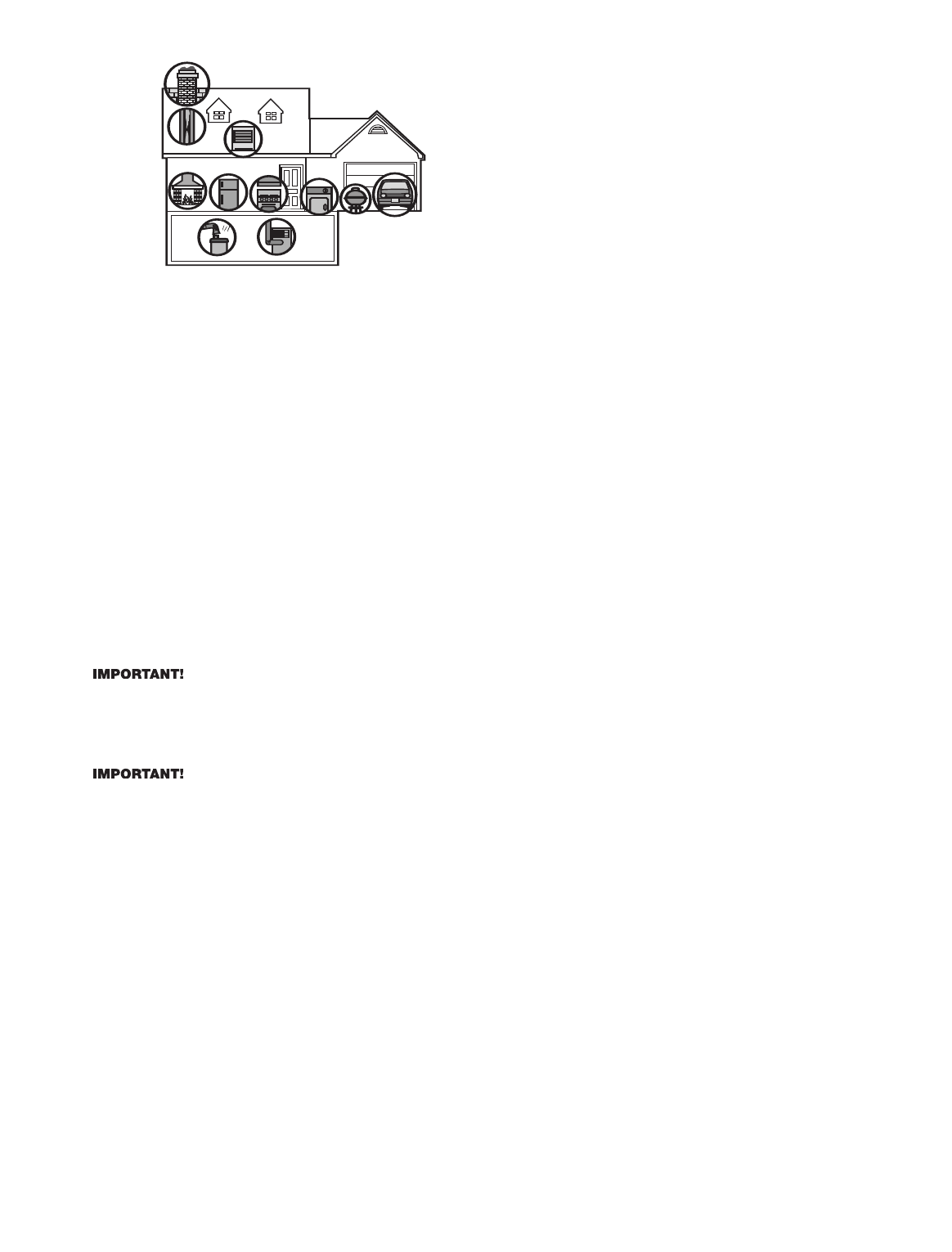
WHAT LEVELS OF CO CAUSE AN ALARM?
Underwriters Laboratories Inc. Standard UL2034 requires residential CO
Alarms to sound when exposed to levels of CO and exposure times as
d
escribed below. They are
measured in parts per million (ppm) of CO over
t
ime (in minutes).
UL2034 Required Alarm Points*:
• If the alarm is exposed to 400 ppm of CO, IT MUST ALARM BETWEEN
4
and 15 MINUTES.
• If the alarm is exposed to 150 ppm of CO, IT MUST ALARM BETWEEN
10 and 50 MINUTES.
• If the alarm is exposed to 70 ppm of CO, IT MUST ALARM BETWEEN
60 and 240 MINUTES.
* Approximately 10% COHb exposure at levels of 10% to 95% Relative
Humidity (RH).
The unit is designed not to alarm when exposed to a constant level
of 30 ppm for 30 days.
CO Alarms are designed to alarm before there is an immediate life threat.
Since you cannot see or smell CO, never assume it’s not present.
• An exposure to 100 ppm of CO for 20 minutes may not affect average,
healthy adults, but after 4 hours the same level may cause headaches.
• An exposure to 400 ppm of CO may cause headaches in average, healthy
adults after 35 minutes, but can cause death after 2 hours.
This CO Alarm measures exposure to CO over time. It alarms if CO levels
are extremely high in a short period of time, or if CO levels reach a certain
minimum over a long period of time. The CO Alarm generally sounds an alarm
before the onset of symptoms in average, healthy adults.
W
hy is this important? Because you need to be warned of a potential CO
problem while you can still react in time. In many reported cases of CO
exposure
, victims may be aware that they are
not feeling well, but become
disoriented and can no longer re
act well enough to exit the building or get
h
elp. Also, young children and pets may be the first affected. The average
healthy adult might not feel any symptoms when the CO Alarm sounds.
However, people with cardiac or respiratory problems, infants, unborn babies,
p
regnant mothers, or elderly people can be more quickly and severely affected
by CO. If you experience even mild symptoms of CO poisoning, consult your
doctor immediately!
Standards: Underwriters Laboratories Inc. Single and Multiple Station carbon
monoxide alarms UL2034.
According to Underwriters Laboratories Inc. UL2034, Section 1-1.2: “Carbon
monoxide alarms covered by these requirements are intended to respond to
the presence of carbon monoxide from sources such as, but not limited to,
exhaust from internal-combustion engines, abnormal operation of fuel-fired
appliances, and fireplaces. CO Alarms are intended to alarm at carbon
monoxide levels below those that could cause a loss of ability to react to the
dangers of Carbon Monoxide exposure.” This CO Alarm monitors the air at
the Alarm, and is designed to alarm before CO levels become life threatening.
This allows you precious time to leave the house and correct the problem.
This is only possible if Alarms are located, installed, and maintained as
described in this manual.
Gas Detection at Typical Temperature and Humidity Ranges:
The CO Alarm is not formulated to detect CO levels below 30 ppm typically.
UL tested for false alarm resistance to Methane (500 ppm), Butane (300 ppm),
Heptane (500 ppm), Ethyl Acetate (200 ppm), Isopropyl Alcohol (200 ppm)
and Carbon Dioxide (5000 ppm). Values measure gas and vapor concentrations
in parts per million.
Audible Alarm: 85 dB minimum at 10 feet (3 meters).
This CO Alarm is intended for residential use. It is not intended for
use in industrial applications where Occupational Safety and Health
Administration (OSHA) r
equirements for carbon monoxide detectors
must be met.
CO alar
ms may not waken all individuals.
If childr
en or others do not r
eadily
waken to the sound of the CO alarm, or if there are infants or family members
with mobility limitations, make sure that someone is assigned to assist them
in the event of an emer
gency
.
CO Alarms will not work without power. This alarm requires two standard
AA batteries to operate.
CO Alarms for Solar or Wind Energy users and battery backup power
systems:
AC power
ed CO Alarms should only be operated with true or pur
e
sine wave inverters. Operating this Alarm with most battery-powered UPS
(uninterruptible power supply) products or square wave or “quasi sine wave”
inverters will damage the Alar
m
. If you ar
e not sur
e about your inverter or
UPS type, please consult with the manufacturer to verify.
This CO Alarm will not sense carbon monoxide that does not reach the
sensor
.
This CO Alarm will only sense CO at the sensor
. CO may be pr
esent
in other areas. Doors or other obstructions may affect the rate at which CO
r
eaches the CO Alarm. For this reason, if bedroom doors are usually closed
at night, we recommend you install a CO Alarm in each bedroom and in the
hallway between them.
CO Alarms may not sense CO on another level of the home. For example,
a CO Alarm on the second level, near the bedr
ooms, may not sense CO in the
basement. For this reason, one CO Alarm may not give adequate warning.
Complete coverage is r
ecommended. Place CO Alarms on each level of the
home.
CO Alarms may not be heard. The alarm horn loudness meets or exceeds
current UL standards of 85 dB at 10 feet (3 meters). However, if the CO Alarm
is installed outside the bedr
oom, it may not wake up a sound sleeper or one
who has r
ecently used drugs or has been drinking alcoholic beverages. This
is especially true if the door is closed or only partly open. Even persons who
are awake may not hear the alarm horn if the sound is blocked by distance or
closed doors. Noise from traffic, stereo, radio, television, air conditioner, or
other appliances may also pr
event alert persons fr
om hearing the alarm horn.
This CO Alarm is not intended for people who are hearing impaired.
CO Alarms are not a substitute for a smoke alarm. Although fire is a
source of carbon monoxide, this CO Alarm does not sense smoke or fire. This
CO Alarm senses CO that may be escaping unnoticed fr
om malfunctioning
furnaces, appliances, or other sources. Early warning of fire requires the
installation of smoke alarms.
CO Alarms are not a substitute for life insurance. Though these CO Alarms
war
n against incr
easing CO levels, BRK Brands, Inc. does not warrant or imply
in any way that they will protect lives from CO poisoning. Homeowners and
renters must still insure their lives.
CO Alar
ms have a limited life.
Although the CO Alarm and all of its parts
have passed many stringent tests and are designed to be as reliable as
possible, any of these parts could fail at any time. Ther
efore, you must test
your CO Alarm weekly.
CO Alar
ms ar
e not foolpr
oof.
Like all other electr
onic devices, CO Alarms
have limitations. They can only detect CO that reaches their sensors. They
may not give early war
ning to rising CO levels if the CO is coming fr
om a
remote part of the home, away from the CO Alarm.
F
uel-burning appliances like:
p
ortable heater, gas or wood burning fireplace,
g
as kitchen range or cooktop, gas clothes dryer.
Damaged or insufficient venting: corroded or disconnected water heater
vent pipe, leaking chimney pipe or flue, or cracked heat exchanger, blocked
o
r clogged chimney opening.
Improper use of appliance/device: operating a barbecue grill or vehicle in
a
n enclosed area (like a garage or screened porch).
T
ransient CO Problems:
“
transient” or on-again-off-again CO problems can
be caused by outdoor conditions and other special circumstances.
GENERAL LIMITATIONS OF CO ALARMS
T
he following conditions can result in transient CO situations:
1
. Excessive spillage or reverse venting of fuel appliances caused by outdoor
conditions such as:
•
Wind direction and/or velocity, including high, gusty winds. Heavy air in
t
he vent pipes (cold/humid air with extended periods between cycles).
• Negative pressure differential resulting from the use of exhaust fans.
•
Several appliances running at the same time competing for limited
f
resh air.
• Vent pipe connections vibrating loose from clothes dryers, furnaces, or
w
ater heaters.
•
Obstructions in or unconventional vent pipe designs which can amplify
the above situations.
2
. Extended operation of unvented fuel burning devices (range, oven,
fireplace).
3
. Temperature inversions, which can trap exhaust close to the ground.
4. Car idling in an open or closed attached garage, or near a home.
These conditions are dangerous because they can trap exhaust in your
home. Since these conditions can come and go, they are also hard to
r
ecreate during a CO investigation.
POTENTIAL SOURCES OF CO IN THE HOME
UNDERWRITERS LABORATORIES INC. UL2034
5













